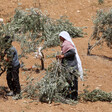Rights and Accountability 13 July 2024

Mourners carry the bodies of four Palestinians killed by an Israeli airstrike late Tuesday during their funeral in the West Bank refugee camp of Nur Shams, near Tulkarm, Wednesday, 3 July.
APA imagesAt any other time in Palestinian history, the West Bank’s resistance to Israel’s lethal military raids and colonial encroachments would earn the title of a third intifada.
Since 7 October, Israel’s military has intensified its raids into occupied West Bank cities, towns and refugee camps. These military operations, which often involve special units and an array of armored vehicles and bulldozers, have wrought widespread devastation, severely damaging electricity networks, water and sewage infrastructure, uprooting roads and destroying homes.
In the West Bank, Israel has been killing Palestinians by various means.
Israeli forces shoot Palestinians at protests, during military incursions or even by carrying out extrajudicial executions.
Now, even aerial attacks in the occupied West Bank is not an unusual occurrence, after the practice was dormant since the second intifada until last summer. Since 7 October, Israel has conducted dozens of airstrikes in the occupied West Bank, killing at least 86 Palestinians, including 14 children, according to records kept by UN monitoring group OCHA.
Armed Palestinian cells have expanded and refined their tactics to resist and confront Israel’s military raids, particularly in northern cities and refugee camps. One such tactic has been the wider use of explosive devices planted within roads where Israeli armored vehicles pass. Palestinians remotely detonate the explosive devices, killing and injuring a number of Israeli soldiers in recent months.
Refined resistance
In under one week, between the end of June and the beginning of July, roadside explosives killed two members of Israel’s army – a sniper team commander who was killed in the Jenin refugee camp in the northern occupied West Bank on 27 June, and a combat driver who was killed in another explosion in the Nur Shams refugee camp near Tulkarm on 1 July.
Under the guise of wanting to uproot explosive devices from roads, Israeli bulldozers ravage through the streets of cities and refugee camps “to shave the upper layer of asphalt on the roads,” as The Times of Israel put it.
This has wreaked havoc on Palestinian communities, commercial stores and civic infrastructure in those areas.
During a 15-hour Israeli military raid in Nur Shams refugee camp on 9 July, bulldozers destroyed roads in and around the camp, damaging water, electricity and internet infrastructure, OCHA reported, in addition to the walls of homes and commercial stores.
The Israeli army claimed that the discovered explosive devices were “targeted toward civilians and Israeli security forces.”
Armed resistance has seemingly adapted to the Israeli army’s methods to combat them and inflict punishment on the entire community in the process. The Times of Israel said the explosive that killed the sniper commander in the Jenin refugee camp was a “100-kilogram” device and may have been placed 1.5 meters underground.
The device that killed the combat driver in the Nur Shams refugee camp also breached his vehicle’s IED protection, severely damaging it and flipping it upside down, suggesting the explosive device was particularly large and powerful.
“All of the explosive devices detonated against Israeli targets in the West Bank over the past year were made of improvised homemade materials, and some were very high quality,” The Times of Israel reported.
The increasingly sophisticated and organized resistance tactics are concerning the Israeli army in the West Bank as it invests in a larger effort to combat it, including an intelligence unit aimed at detecting them.
Since the beginning of the year, the Israeli army dismantled production labs for these explosives, as well as discovered and neutralized planted devices, the Israeli newspaper reported, figures that likely originate with the Israeli military. Around 1,000 IEDs targeted Israeli troops.
Since 7 October and through 8 July, 14 Israelis, including nine soldiers and five settlers, have been killed in the occupied West Bank, OCHA said.
Deadly raids
Children bear the brunt of Israel’s lethal military incursions into West Bank towns, cities and refugee camps.
An atmosphere of constant impunity demonstrates Israeli soldiers’ “contempt for Palestinian children’s lives,” said Ayed Abu Eqtaish, accountability program director at Defense for Children International - Palestine.
On Thursday, as Israeli forces withdrew from nearby Palestinian villages, they passed by the entrance of Meithalun, a town in the Jenin area. Palestinians threw stones at the invading Israeli military vehicles.
One kid who allegedly threw stones at Israeli forces near the entrance of Meithalun was fatally shot by an occupation soldier.
An Israeli soldier in a heavily armored vehicle shot 14-year-old Ali Hasan Ali Rabaya from a close distance of 20 to 40 meters, striking him under the armpit.
Ali managed to run for about three meters before collapsing to the ground.
“Israeli forces continued firing in Ali’s direction, striking at least five other Palestinian children,” DCIP reported.
Israeli military fire continued for about five minutes, preventing any nearby Palestinians from approaching Ali to provide medical care or transport him. It was only when Israeli military vehicles withdrew from the area that Ali was transferred to a nearby hospital by private car, where he was pronounced dead.
Meanwhile, Israeli forces killed 14-year-old Ghassan Gharib Zahran while he played with two friends at the entrance of the Palestinian village of Deir Abu Mashal, west of Ramallah.
Three Israeli soldiers traveling in a vehicle nearby opened fire on the kids from a distance of 80 to 100 meters, striking Ghassan in his back, DCIP said.
“A group of Israeli settlers gathered after Israeli soldiers shot Ghassan and began throwing stones at Palestinian village residents attempting to reach him,” DCIP said.“Israeli forces opened fire on the Palestinian residents to prevent them from reaching the child, who remained lying on the ground bleeding for 15 to 20 minutes.”
“Unlawful killings of Palestinian children have become the norm as Israeli forces become increasingly empowered to use intentional lethal force in situations that are not justified,” said Abu Eqtaish.
“In short, these are war crimes with no consequence.”
Israeli forces and settlers have killed 57 Palestinian children since the beginning of the year, including two US citizens, according to documentation by DCIP.
More than 550 Palestinians have been killed in the occupied West Bank since 7 October, including at least 536 by Israeli forces, according to OCHA.
Israeli settlers have killed at least 11 Palestinians, and another six were killed by either Israeli army or settler fire.
Of those killed in the occupied West Bank since 7 October, 137 were children.
At least 246 of those killings have happened since the beginning of 2024, according to the Palestinian Center for Human Rights. Over 700 Palestinians, including 150 children, were injured.
Israeli forces and settlers have injured over 5,500 Palestinians in the West Bank since 7 October, at least 800 of them children. One third of all injuries were by live ammunition.




